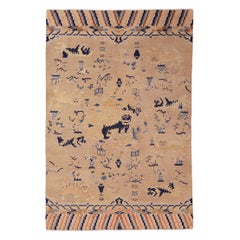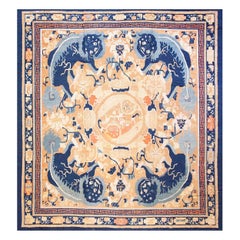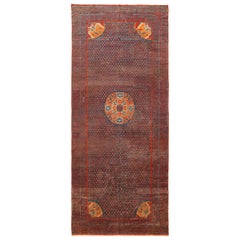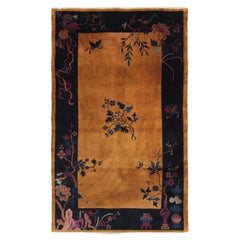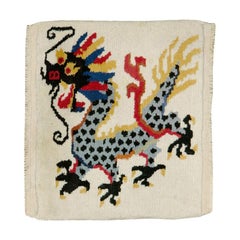Chinese More Carpets
7
to
5
2
7
7
7
7
36
332
312
144
75
89
4
1
6
11
3
9
2
6
28
Width
to
Length
to
7
7
23,010
36
33
22
13
Period: 18th Century and Earlier
Place of Origin: Chinese
Chinese Imperial Foo Dog, 18th Century
Located in Ferrara, IT
This ancient Chinese carpet knotted in the Ningxia area in the 18th century measures 290 × 196 cm (9' 6" × 6' 5"). From traditional Chinese iconography the decoration takes flower in...
Category
18th Century Other Antique Chinese More Carpets
Materials
Wool
16th Century Ming Dynasty Dragon Chinese Carpet Fragment. 3 ft x 3 ft
Located in New York, NY
Breathtaking and Highly Collectible Antique 16th Century Ming Dynasty Dragon Chinese Fragment, Country of Origin: China, Circa Date: 16th Century. Si...
Category
16th Century Other Antique Chinese More Carpets
Materials
Wool
Antique Distressed Chinese Rug
Located in Saint Ouen, FR
Large distressed antique Chinese rug probably, late 18th or early 19th century
Some old reparations, with nice Chinese design and beautiful colors with yellow and blue, entirely han...
Category
Late 18th Century Chinoiserie Antique Chinese More Carpets
Materials
Wool
18th Century Chinese Ningxia Main Hall Carpet ( 12'8''x13'4''- 385 x 405 )
Located in New York, NY
Main Hall Carpet
Ningxia
North Central China
First Half of the 18th century
Measures: 12'8" x 13'4" - 386 x 406 cm
Structural Analysis
Warp: cotton, white, natural, Z-4-S, hand-spun...
Category
1720s Antique Chinese More Carpets
Materials
Wool
Antique Chinese Peking Wedding Rug with Chinoiserie Style
Located in Dallas, TX
77267 Antique Chinese Peking Wedding Rug with Art Deco Chinoiserie Style. This hand knotted wool antique Chinese Peking rug features a rounded open center ...
Category
Early 17th Century Chinoiserie Antique Chinese More Carpets
Materials
Wool
18th Century Antique Chinese Kansu Rug. 6 ft 7 in x 15 ft 6 in
Located in New York, NY
Beautiful 18th Century Antique Chinese Kansu Gallery Size Rug, Country Of Origin: China, Circa Date: 18th Century. Size: 6 ft 7 in x 15 ft 6 in (2.01 m x 4.72 m)
Category
18th Century Chinese Export Antique Chinese More Carpets
Materials
Wool
Antique Chinese Ningxia Rug. Size: 6 ft 2 in x 12 ft
Located in New York, NY
Late 17th Century Chinese Ningxia Rug, Country of Origin / Rug Type: China Rugs, Circa Date: Late 17th Century – Size: 6 ft 2 in x 12 ft (1.88 m x 3.66 m)
Unlike many traditional Chinese rugs...
Category
Late 17th Century Chinese Export Antique Chinese More Carpets
Materials
Wool
Related Items
Antique Art Deco Rug Antique Chinese Rug Chinese Rug 1920 Gold Chinese Rug
Located in New York, NY
Rare antique Art Deco rug Chinese rug antique Chinese rug
3'10" x 6'6" 4' x 7'
110cm x 199cm
Circa 1920
"Beautiful antique Art Deco rug...
Category
1920s Vintage Chinese More Carpets
Materials
Wool
Mid-20th Century Handmade Chinese Art Deco Pictorial Dragon Throw Rug
Located in New York, NY
A vintage Chinese Art Deco throw rug handmade during the mid-20th century with a pictorial design of a dragon in black, blue, red, goldenrod, and light blue-grey over a cream-white borderless field.
Measures: 1' 3" x 1' 6"
The craft of the hand-knotted carpet in China, and the surrounding areas including Mongolia and Tibet, extends into the early centuries of the first millennium, C.E., but we really have a firm grasp only beginning in the later 16th century with large, very coarsely woven carpets, often depicting dragons, created for the Imperial Forbidden City palaces. Chinese carpets have always been commercial and there are no tribal groups responsible for any of the carpet weaving strains.
When the Ming Dynasty fell in 1644, with no Imperial patrons, production moved to the city of Ningxia in north central China where several workshops turned out more finely woven pieces for the Mandarins of the administrative Ch’ing bureaucracy and well-to-do merchants. Ningxia was the major Chinese carpet center up through most of the 19th century, with first allover and then medallion designs on cotton foundations in medium weaves. Palettes were initially limited to yellows, dark blue and cream, but later widened to include reds, browns and even green. These antiques were the first Chinese carpets to be exported to the West and they fitted in well with the craze for Chinese blue-and-white porcelain in the second half of the 19th century. Ningxia also wove shaped and rectangular small rugs for saddle underlays, chair (“throne”) seats and shaped backs, pillar carpets with dragons or monks for Buddhist monasteries, and long divided runners for monastery meditation halls. These small rugs are among the most collectible of all Chinese weavings.
Weavers from Ningxia set up workshops in the capital Peking (Beijing) in the 1860’s and began weaving Western room sizes for export, primarily to America. In blue – and – white and polychrome palettes, with round wreath medallions, precious objects, seasonal flowers, paeonies, lotuses, fretwork, clouds, butterflies and bats, all relatively spaciously drawn. The round “Shou” (Good Luck) character is also a prominent decorative motif. There are also a few Peking landscape pictorials with pagodas, houses, bridges, waterscapes and boats. Peking carpets were woven right up until WWII and production began again after the Cultural Revolution around 1970. They are moderately well-woven, on cotton foundations, exactingly executed and indisputably Chinese. Many are in the blue-and-white style. Nothing else looks like a Peking carpet and for a Chinese “look” in a room, they are absolutely indispensable. Sizes range from scatters and a few runners, through the popular 9’12’ size, to large carpets over 20’ which must have been special orders. The earliest Peking Revival carpets are pliable and fairly thin, but they became heavier and more compact in the 20th century, in competition with Art Deco carpets from Tientsin. The modern, post- 1970, pieces are in the traditional Peking style, but are a little too regular and neat. Exactitude has been favored over character, as hard to explain that as it is.
There are a number of all-silk and silk-and –metal thread pieces, many with inscriptions purporting to link them with rooms in the Imperial palaces, bringing very substantial auction prices, but none are really antique. The genre emerged after WWI and the present demand comes from mainland Chinese. The silk piles often stand in pattern relief against flat woven gold metal thread grounds. The inscriptions are apocryphal, the rugs are flashily opulent, perfect for nouveaux riches.
The Art Deco period between the two World Wars saw a distinctive carpet industry developing in Tientsin (Tianjin) in northeastern China. These are highly prized for their transitional design character, neither overtly Chinese, nor abstractly modern/contemporary. Woven exclusively for export, usually by and for American firms, such as Nichols and Elbrook, they are totally in the “Jazz Age Modern” style of the 1920’s, often without borders, with abstract or abstracted patterns, and only with, at best, a few Chinese-y pattern elements. Vases asymmetrically placed in the corners are features of some of the more Chinese-y carpets. Open fields with floral sprays and branches growing in from the edges are anther design innovation. Often, Chinese motives have been re-imagined in more sharp-edged, abstract manners. Some have no references whatsoever to natural elements. The patterns are sharp and the rugs are never subdued, soft or restrained. The rugs are heavily constructed, with crisp, unfading dyes and medium to medium coarse weaves on cotton foundations. All are extremely well-executed, with none of the vagaries, variations or twists found on even high-quality Persian rugs. The majority are in the 9’ by 12’ format and a surprising number can be found in top condition. There also was a substantial production in Peking from, especially from the Fette factory. Elliptical and round carpets, and lighter, often pastel colors, were a specialty. Nothing looks like an Art Deco Chinese and they work well with traditional Chinese furniture and the most modern decor as well. These is no substitute for a good Chinese Art Deco carpet.
Chinese carpets also include small scatters from Tibet, with high quality wool, floating dragons and allover textile patterns. The colors of vintage and modern pieces are bright, but there are antique small rugs...
Category
Mid-20th Century Art Deco Chinese More Carpets
Materials
Wool
Antique Chinese Baotou Indigo Rug, circa 1900
Located in Ottawa, Ontario
Antique Chinese Baotou indigo rug, circa 1900. The central field with an intricate lattice work of Traditional Gau (Amulet) design in two shades of blue...
Category
Early 20th Century Chinese Export Chinese More Carpets
Materials
Wool
Distressed Antique Chinese Peking Rug with Romantic Chinoiserie Style
Located in Dallas, TX
77561, distressed antique Chinese Peking rug with Romantic chinoiserie style1. This hand knotted wool distressed antique Chinese Peking rug features a rounded open center medallion floating on an abrashed blue field. The medallion is comprised of a swirl of floral motifs surrounding a fretwork pattern with a small rosette in the center. Peonies and butterflies gracefully surround the medallion. Peonies are one of the most treasured symbols throughout Chinese art and design; the flower is seen to represent unparalleled beauty and honor. Butterflies are thought to represent happiness. Delicate scrollwork adorns the spandrels, echoing the floral tendrils and butterfly shapes in the field design. A gorgeous traditional peony border frames the composition. The restrained color palette based around shades of blues, creams, and apricot accents, creates a sense of serenity and elegance. With its Classic design, well-harmonized color palette, and graceful floral motifs, this antique Chinese Peking rug would be a refined, yet comfortable, addition to any interior. It is rendered in variegated shades of royal blue, true blue, indigo...
Category
Early 20th Century Chinoiserie Chinese More Carpets
Materials
Wool
Early 20th Century Handmade Chinese Ningxia Square Throw Rug
Located in New York, NY
An antique Chinese Ningxia square throw rug handmade during the early 20th century.
Measures: 2' 3" x 2' 4"
The craft of the hand-knotted carpet in China, and the surrounding areas including Mongolia and Tibet, extends into the early centuries of the first millennium, C.E., but we really have a firm grasp only beginning in the later 16th century with large, very coarsely woven carpets, often depicting dragons, created for the Imperial Forbidden City palaces. Chinese carpets have always been commercial and there are no tribal groups responsible for any of the carpet weaving strains.
When the Ming Dynasty fell in 1644, with no Imperial patrons, production moved to the city of Ningxia in north central China where several workshops turned out more finely woven pieces for the Mandarins of the administrative Ch’ing bureaucracy and well-to-do merchants. Ningxia was the major Chinese carpet center up through most of the 19th century, with first allover and then medallion designs on cotton foundations in medium weaves. Palettes were initially limited to yellows, dark blue and cream, but later widened to include reds, browns and even green. These antiques were the first Chinese carpets to be exported to the West and they fitted in well with the craze for Chinese blue-and-white porcelain in the second half of the 19th century. Ningxia also wove shaped and rectangular small rugs for saddle underlays, chair (“throne”) seats and shaped backs, pillar carpets with dragons or monks for Buddhist monasteries, and long divided runners for monastery meditation halls. These small rugs are among the most collectible of all Chinese weavings.
Weavers from Ningxia set up workshops in the capital Peking (Beijing) in the 1860’s and began weaving Western room sizes for export, primarily to America. In blue – and – white and polychrome palettes, with round wreath medallions, precious objects, seasonal flowers, paeonies, lotuses, fretwork, clouds, butterflies and bats, all relatively spaciously drawn. The round “Shou” (Good Luck) character is also a prominent decorative motif. There are also a few Peking landscape pictorials with pagodas, houses, bridges, waterscapes and boats. Peking carpets were woven right up until WWII and production began again after the Cultural Revolution around 1970. They are moderately well-woven, on cotton foundations, exactingly executed and indisputably Chinese. Many are in the blue-and-white style. Nothing else looks like a Peking carpet and for a Chinese “look” in a room, they are absolutely indispensable. Sizes range from scatters and a few runners, through the popular 9’12’ size, to large carpets over 20’ which must have been special orders. The earliest Peking Revival carpets are pliable and fairly thin, but they became heavier and more compact in the 20th century, in competition with Art Deco carpets from Tientsin. The modern, post- 1970, pieces are in the traditional Peking style, but are a little too regular and neat. Exactitude has been favored over character, as hard to explain that as it is.
There are a number of all-silk and silk-and –metal thread pieces, many with inscriptions purporting to link them with rooms in the Imperial palaces, bringing very substantial auction prices, but none are really antique. The genre emerged after WWI and the present demand comes from mainland Chinese. The silk piles often stand in pattern relief against flat woven gold metal thread grounds. The inscriptions are apocryphal, the rugs are flashily opulent, perfect for nouveaux riches.
The Art Deco period between the two World Wars saw a distinctive carpet industry developing in Tientsin (Tianjin) in northeastern China. These are highly prized for their transitional design character, neither overtly Chinese, nor abstractly modern/contemporary. Woven exclusively for export, usually by and for American firms, such as Nichols and Elbrook, they are totally in the “Jazz Age Modern” style of the 1920’s, often without borders, with abstract or abstracted patterns, and only with, at best, a few Chinese-y pattern elements. Vases asymmetrically placed in the corners are features of some of the more Chinese-y carpets. Open fields with floral sprays and branches growing in from the edges are anther design innovation. Often, Chinese motives have been re-imagined in more sharp-edged, abstract manners. Some have no references whatsoever to natural elements. The patterns are sharp and the rugs are never subdued, soft or restrained. The rugs are heavily constructed, with crisp, unfading dyes and medium to medium coarse weaves on cotton foundations. All are extremely well-executed, with none of the vagaries, variations or twists found on even high-quality Persian rugs. The majority are in the 9’ by 12’ format and a surprising number can be found in top condition. There also was a substantial production in Peking from, especially from the Fette factory. Elliptical and round carpets, and lighter, often pastel colors, were a specialty. Nothing looks like an Art Deco Chinese and they work well with traditional Chinese furniture and the most modern decor as well. These is no substitute for a good Chinese Art Deco carpet.
Chinese carpets also include small scatters from Tibet, with high quality wool, floating dragons and allover textile patterns. The colors of vintage and modern pieces are bright, but there are antique small rugs...
Category
Early 20th Century Art Deco Chinese More Carpets
Materials
Wool
Distressed Antique Chinese Art Deco Oval Rug
Located in Dallas, TX
77615 distressed antique Chinese Art Deco oval rug 03'00 x 04'09. This hand-knotted wool distressed antique Chinese Art Deco style rug features a bea...
Category
Early 20th Century Art Deco Chinese More Carpets
Materials
Wool
Antique Art Deco Rug Antique Chinese Rug Tree of Life Chinese Rug 1920
Located in New York, NY
9x12 Rare Antique Art Deco Rug Chinese Rug Tree of Life rug
267cm x 346cm
8'9" x 11'4"
9x12
Circa 1920
"This is a magnificent unique antique Art Deco rug. It has a fine quality, and fabulous colorway. This piece has incredible design elements including a tree of life, vase, butterflies and exotic flowers. Pieces like this are hard to come by and are extremely desired."-Antique Rug Collection
Size
8'9" X 11'4"
Serial ID #
20894k
Design
Art Deco
Metric Size
267cm x 346cm
Age
1920 Antique
Category
Art Deco
Pattern
Art Deco, Exotic Flowers
Material
100% Hand Knotted Wool
Foundation Material
Cotton
Color
Grey, Beige, Pink, Blue, Ivory, Orange, Green, Yellow
Quality
High Quality
Condition
Great Condition, Minute low area
About Us~ Welcome to Antique Rug Collection. Your #1 Source for handmade Antique Rugs & Tapestries at great prices, curated by leading industry expert. We are a 6th Generation antique rug shop with 48+ years of experience working with designers, private clients, dealers, and really anyone looking for a unique antique rug at a great price. We've made an imprint selling rugs...
Category
1920s Vintage Chinese More Carpets
Materials
Wool
Mid-20th Century Handmade Chinese Pictorial Accent Rug of Horses
Located in New York, NY
A vintage Chinese pictorial accent rug handmade during the mid-20th century of horses prancing in a field over a dark midnight blue background.
Measures: 4' 0" x 6' 6".
Category
Mid-20th Century Modern Chinese More Carpets
Materials
Wool
19th Century Chinese Qing Dynasty Silk Embroidery Altar Banner
Located in Vancouver, British Columbia
Fine Qing Dynasty Chinese Altar weaving hand embroidered in silk. Intricate and complex weave depicting a celebration of Spring with a Royal Court Scene rendered in breathtaking deta...
Category
1870s Qing Antique Chinese More Carpets
Materials
Satin
Mid-20th Century Handmade Chinese Art Deco Throw Rug
Located in New York, NY
A vintage Chinese Art Deco throw rug handmade during the mid-20th century.
Measures: 2' 8" x 3' 9"
The Craft of the hand-knotted carpet in China, and the surrounding areas including Mongolia and Tibet, extends into the early centuries of the first millennium, C.E., but we really have a firm grasp only beginning in the later 16th century with large, very coarsely woven carpets, often depicting dragons, created for the Imperial Forbidden City palaces. Chinese carpets have always been commercial and there are no tribal groups responsible for any of the carpet weaving strains.
When the Ming Dynasty fell in 1644, with no Imperial patrons, production moved to the city of Ningxia in north central China where several workshops turned out more finely woven pieces for the Mandarins of the administrative Ch’ing bureaucracy and well-to-do merchants. Ningxia was the major Chinese carpet center up through most of the 19th century, with first allover and then medallion designs on cotton foundations in medium weaves. Palettes were initially limited to yellows, dark blue and cream, but later widened to include reds, browns and even green. These antiques were the first Chinese carpets to be exported to the West and they fitted in well with the craze for Chinese blue-and-white porcelain in the second half of the 19th century. Ningxia also wove shaped and rectangular small rugs for saddle underlays, chair (“throne”) seats and shaped backs, pillar carpets with dragons or monks for Buddhist monasteries, and long divided runners for monastery meditation halls. These small rugs are among the most collectible of all Chinese weavings.
Weavers from Ningxia set up workshops in the capital Peking (Beijing) in the 1860’s and began weaving Western room sizes for export, primarily to America. In blue – and – white and polychrome palettes, with round wreath medallions, precious objects, seasonal flowers, paeonies, lotuses, fretwork, clouds, butterflies and bats, all relatively spaciously drawn. The round “Shou” (Good Luck) character is also a prominent decorative motif. There are also a few Peking landscape pictorials with pagodas, houses, bridges, waterscapes and boats. Peking carpets were woven right up until WWII and production began again after the Cultural Revolution around 1970. They are moderately well-woven, on cotton foundations, exactingly executed and indisputably Chinese. Many are in the blue-and-white style. Nothing else looks like a Peking carpet and for a Chinese “look” in a room, they are absolutely indispensable. Sizes range from scatters and a few runners, through the popular 9’12’ size, to large carpets over 20’ which must have been special orders. The earliest Peking Revival carpets are pliable and fairly thin, but they became heavier and more compact in the 20th century, in competition with Art Deco carpets from Tientsin. The modern, post- 1970, pieces are in the traditional Peking style, but are a little too regular and neat. Exactitude has been favored over character, as hard to explain that as it is.
There are a number of all-silk and silk-and –metal thread pieces, many with inscriptions purporting to link them with rooms in the Imperial palaces, bringing very substantial auction prices, but none are really antique. The genre emerged after WWI and the present demand comes from mainland Chinese. The silk piles often Stand in pattern relief against flat woven gold metal thread grounds. The inscriptions are apocryphal, the rugs are flashily opulent, perfect for nouveaux riches.
The Art Deco period between the two World Wars saw a distinctive carpet industry developing in Tientsin (Tianjin) in northeastern China. These are highly prized for their transitional design character, neither overtly Chinese, nor abstractly modern/contemporary. Woven exclusively for export, usually by and for American firms, such as Nichols and Elbrook, they are totally in the “Jazz Age Modern” style of the 1920’s, often without borders, with abstract or abstracted patterns, and only with, at best, a few Chinese-y pattern elements. Vases asymmetrically placed in the corners are features of some of the more Chinese-y carpets. Open fields with floral sprays and branches growing in from the edges are anther design innovation. Often, Chinese motives have been re-imagined in more sharp-edged, abstract manners. Some have no references whatsoever to natural elements. The patterns are sharp and the rugs are never subdued, soft or restrained. The rugs are heavily constructed, with crisp, unfading dyes and medium to medium coarse weaves on cotton foundations. All are extremely well-executed, with none of the vagaries, variations or twists found on even high-quality Persian rugs. The majority are in the 9’ by 12’ format and a surprising number can be found in top condition. There also was a substantial production in Peking from, especially from the Fette factory. Elliptical and round carpets, and lighter, often pastel colors, were a specialty. Nothing looks like an Art Deco Chinese and they work well with traditional Chinese furniture and the most modern decor as well. These is no substitute for a good Chinese Art Deco carpet.
Chinese carpets also include small scatters from Tibet, with high quality wool, floating dragons and allover textile patterns. The colors of vintage and modern pieces are bright, but there are antique small rugs...
Category
Mid-20th Century Art Deco Chinese More Carpets
Materials
Wool
Antique Chinese Five Claw Dragon Pictorial Rug
Located in Dallas, TX
77589, antique Chinese Five Claw Dragon Pictorial rug. This hand-knotted wool antique Chinese pictorial rug depicts a five claw dragon design. The abrashed orange field features an a...
Category
Early 20th Century Chinoiserie Chinese More Carpets
Materials
Wool
Antique Chinese Peking Rug
Located in New York, NY
Mid 20th century Chinese Floral design rug in predominantly navy blue
Measures: 4'10'' x 7'8''.
Category
20th Century Minimalist Chinese More Carpets
Materials
Wool
Previously Available Items
18th Century Antique Chinese Animal Rug. Size: 4 ft 2 in x 5 ft 9 in
Located in New York, NY
Beautiful 18th Century Antique Chinese Animal Rug, Origin: China, Circa date: 18th Century. Size: 4 ft 2 in x 5 ft 9 in (1.27 m x 1.75 m)
Category
18th Century Chinese Chippendale Antique Chinese More Carpets
Materials
Wool
17 Century Cloudband Antique Chinese Ningxia Runner
Located in New York, NY
A breathtaking rare and collectible antique 17th century Chinese Ningxia runner rug, country of origin / rug type: antique Chinese rug, date circa 17th century - Size: 2 ft 6 in x 15...
Category
17th Century Chinese Chippendale Antique Chinese More Carpets
Materials
Wool
Nazmiyal Antique 17th Century Chinese Fu Dogs Rug. 6 ft 5 in x 10 ft 5 in
Located in New York, NY
Beautiful antique 17th century Chinese Fu / Foo dogs rug, country of origin: China, date circa mid-17th century. Size: 6 ft 5 in x 10 ft 5 in (1.96 m x 3.17 m).
Category
Mid-17th Century Chinese Chippendale Antique Chinese More Carpets
Materials
Wool
Antique Ningsia Rug
Located in New York, NY
Made in an imperial Chinese manufactury, this stunning antique Ningsia is indeed fit for a palace.
Beautiful Gold Colored background Antique Chinese Ningsia rug, Country Of Origin /...
Category
17th Century Chinese Export Antique Chinese More Carpets
Materials
Wool
Antique 18th Century Turkish Smyrna Oushak Rug. Size: 10 ft 5 in x 15 ft 5 in
Located in New York, NY
Beautiful Antique Turkish Smyrna Oushak rug, country of origin: Turkey, date circa 18th century. Size: 10 ft 5 in x 15 ft 5 in (3.17 m x 4.7 m)
Through the skillful use of fiery col...
Category
18th Century Oushak Antique Chinese More Carpets
Materials
Wool
Chinese Ming Carpet Fragment
Located in San Francisco, CA
Interest in Chinese carpets has been growing sharply and with it some important insights into the history of pile weaving in China. This fragment belonged to an important large imperial Ming...
Category
18th Century and Earlier Antique Chinese More Carpets
Materials
Wool
Pair of Antique Ning Hsia Seat Covers
Located in San Francisco, CA
A lovely pair of early Chinese mats, still joined by their warp threads, the way they came off the loom two centuries ago.
Category
18th Century and Earlier Antique Chinese More Carpets
Materials
Wool
Recently Viewed
View AllMore Ways To Browse
Antique Store Bar
Long Gustavian
Blue Lockers
Blue Locker
Cabin On Lake
Elizabethan Antique
Spanish Colonial Small Furniture
Japanese Style Rug
Japan Style Rug
Vintage Style Bathroom Light
Entryway Victorian
Vintage Belgian Wool Rug
Provincial French Cottage Floral Rug
Cream Accessories Home
English Antique Aesthetic Movement Furniture
Midcentury Aztec
French Floral Area Rugs
Arts And Crafts Runner Rugs
